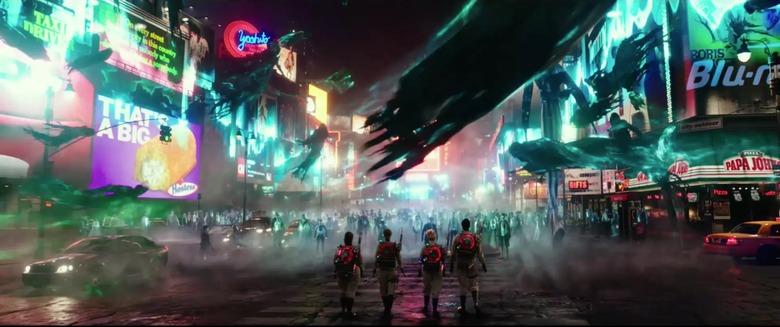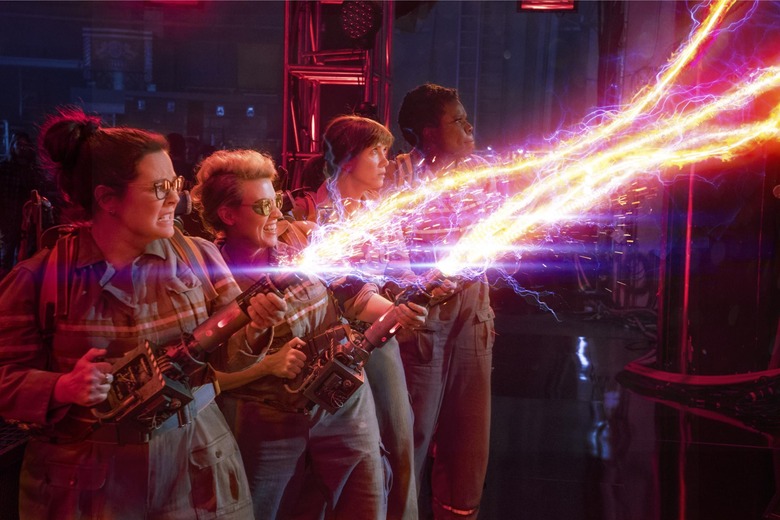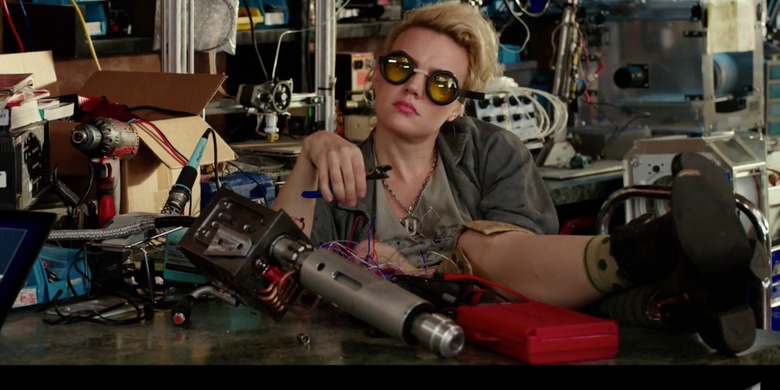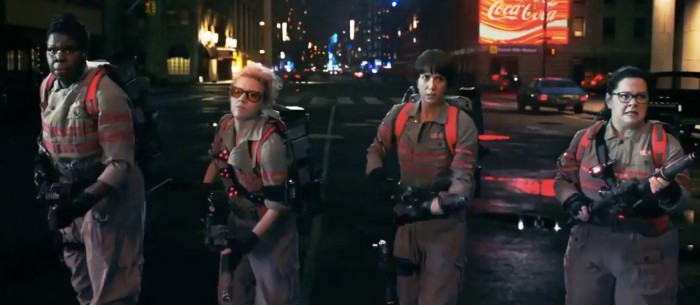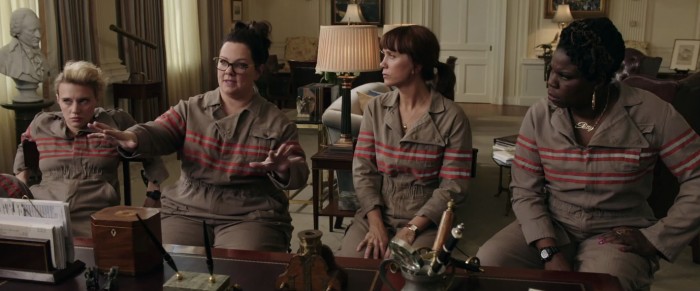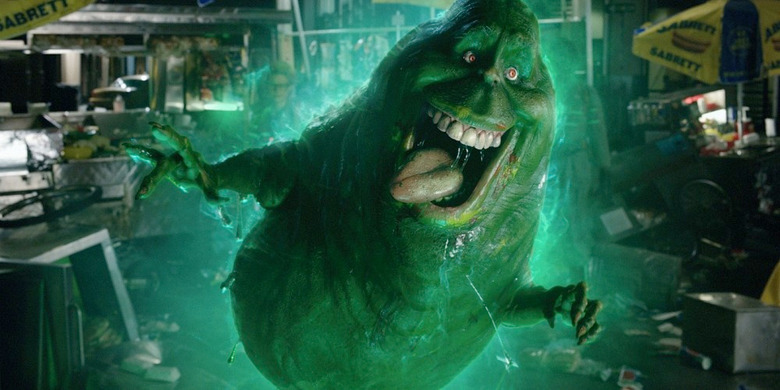'Ghostbusters' Spoiler Review: How Does The New Version Stack Up Against The Original?
If you had told me two years ago that the new Ghostbusters movie would be the source of so much bitter, angry contention, I would have called you a liar. But here we are. The movie has been out for a few days. You've had a chance to see it. I've had a chance to see it. We can finally talk about it like civilized adults.
And I think it's a good movie, maybe even a very good movie. At the very least, it's colorful and funny and spooky and populated by actors I like watching. It's certainly no disaster, despite what any wrongheaded internet campaigns are trying to tell you. Director Paul Feig has made a movie that feels right at home in the Ghostbusters legacy...even though it tries too hard to pay tribute to that legacy.
What Makes a Ghostbusters Movie?
Let's break the mere concept of a Ghostbusters movie down to its basic elements.
There are the obvious components, like a team of people in jumpsuits who do battle with the supernatural. There have to be ghosts, of course, and they have to be just spooky and scary enough to provide a new necessary thrills and chills while being silly enough to stay in line with a comedic tone. Because yes, a Ghostbusters movie is first and foremost comedy, albeit a comedy where the jokes and gags are worked into a larger texture where the threat on hand actually matters. Perhaps most importantly, a Ghostbusters is an underdog tale, a story of overlooked and misunderstood geniuses who work to overcome the fact that every single person who comes into contact with them either thinks they're charlatans or is simply embarrassed to be in their presence. This final ingredient is the knife that stabs 1989's Ghostbusters II in the back – after the events of the first film, it's impossible to believe that anyone would treat those four guys as jokes.
Paul Feig's new Ghostbusters contains all of these elements and goes to the trouble and re-arranging them in a pleasing new order. However, at its core, it is very much in line with what has come before, which makes all of the outlandish hate the film has received from the so-called faithful so incredibly misguided. Like the original film (which remains a classic and still exists and you'll be able to watch it forever), the remake is just scary enough and just dramatic enough to give just enough weight to villain and the supernatural beings that surround him. Against this backdrop, the four leads are allowed to riff and joke and interact with an environment that is more straight faced than them in clever ways. And most importantly, the film has found a way to make them perpetual underdogs, with the New York City mayor's office acknowledging their contributions in private while going out of their way to treat them like charlatans in public. This is very much the mixture of ideas that worked so well decades ago fine-tuned and remixed for 2016. The only real difference between this and the original film is that the team is composed of four women instead of four men.
The thing about Ghostbusters '16 is that it is no radical reinvention, and if anything, it holds the original film in too high regard for its own good (more on that in a bit). It's a funny movie where funny people battle ghosts and save New York City. It's silly. It's broad. Some gags work and others fall flat. The character interactions help us power through any rough stretch. It's such a Ghostbusters movie.
The New Team Dynamic
The dynamic between Venkman, Ray, Egon and Winston in the original Ghostbusters was that of colleagues, men who were friendly with one another in the workplace and functioned as an effective unit in the field. The dynamic between Erin Gilbert (Kristen Wiig), Abby Yates (Melissa McCarthy), Jillian Holtzmann (Kate McKinnon), and Patty Tolan (Leslie Jones) is strikingly different: these four ladies come across on screen as actual friends who enjoy each other's company. The result is a team that, by design, features a lot more heart. There are fewer scenes of vicious Bill Murray sarcasm and more scenes of four women bonding over their shared enthusiasms and troubled backstories. It's impossible to imagine any member of the original four opening up about their pain quite like Gilbert does when she shares the origin of her obsession with ghosts.
This means Ghostbusters '16 is a sweeter experience than the movie it's remaking, which falls right into Feig's wheelhouse. Ivan Reitman made masculine, sarcastic, anarchic comedies and he made them damn well. Feig makes raunchy but good-natured comedies about outsiders who grow together despite their differences. To understand what interests each filmmaker, you must simply look at how their Ghostbuster team functions.
In addition to being a friendlier line-up, the 2016 Ghostbusters also double down on my favorite aspect of the original film: these characters are scientists. Well, three of the them are scientists, but Tolan is well-read New York City history buff whose contributions to the team dynamic genuinely matter. Both Ghostbusters films are about science being taken from the lab and put on the streets. Both films are about lab coats being replaced with a working person's coverall. Both films are about people with big brains being forced to get their hands dirty to pursue knowledge. Both films espouse the same message: being smart is cool and science exists far outside of the textbook you half-read in high school. Being an outsider, an oddball, is totally fine. Go for it. You do you. You do it well enough and maybe you'll save the world.
Of course, the new team has to deal with an additional layer of sexism that the original crew did not, but Feig doesn't overplay his hand on this angle. The sometimes obvious and sometimes subtle misogyny this crew grapples with is present in many scenes, often in the use of a particular phrase or even a carefully chosen word. If you take into account all of the hell the internet has put this movie through prior to its release, the movie starts to feel like a terrific guide for how to let casual sexism bounce right off of you. Ignore the haters and kick ass anyway. Every little girl on the face of the planet should watch Ghostbusters.
A Cast Consisting of Every Funny Person on the Planet
Like any comedy with good taste, Ghostbusters decided to raid the cast of Veep to fill out its margins and the results are sublime. With bit parts played by the likes of Zach Woods, Matt Walsh, Sam Richardson, Jessica Chaffin, and Jamie Denbo, even the most standard scenes are guaranteed a chuckle or two. And that's before you get to Ed Begley Jr. and Charles Dance contributing well-seasoned deadpans, Cecily Strong and Andy Garcia (whose line about not being the mayor from Jaws is an all-timer) providing well-timed bursts of lunacy, and Neil Casey (another Veep veteran) finding the right balance of creepy and silly that you want in a Ghostbusters baddie. As the painfully dim-witted receptionist Kevin, Chris Hemsworth showcases a knack for goofy comedy that needs to be exploited by as many films as possible (his line about aquariums being submarines for fish is another all-timer).
But like the first film, Ghostbusters '16 is a showcase for its major players, all of whom step up to the plate in a big way. Kate McKinnon has rightfully won her fair share of accolades for playing Holtzmann – the batty engineer of the group whose lack of concern for safety is outweighed by the increasingly devastating ghost-hunting equipment she cooks up – and it's easy to imagine her giving Harley Quinn a run for her money in the go-to cosplay costume for female Comic-Con attendees. Her casual oddness and apparent pansexuality make a character who could have only been created in 2016. McKinnon makes eccentricity sexy, finding and exposing the beating heart underneath a potentially silly comic relief oddball.
Equally successful is Leslie Jones as Patty, the former MTA worker who stumbles into the team and ends up acting as the sounding board for the eggheads. Jones has been stealing Saturday Night Live sketches from more famous faces for years now, so it's about time someone gave her a shot to strut her stuff on the big screen. She's brimming with confidence in every scene. She's funny and fierce and we totally buy her instant friendship with these women.
Kristen Wiig and Melissa McCarthy have the two thankless roles. As the straight-as-an-arrow leads, they have to balance the more ribald silliness of the other two leads and provide the emotional core of the movie. In other words, they are, by design, the two "boring" ones, the two who get fewer laughs just so they can make everyone else around them funnier. However, Feig and screenwriter Katie Dippold wisely decide to make them the emotional center of the movie. There are no tedious romantic entanglements in the new Ghostbusters, but there is Gilbert and Yates' friendship, which is on the ropes when the film starts and finds itself tested time and time again throughout the movie. In the grand climax, Gilbert literally leaps into a portal leading to the afterlife to rescue her best friend, a gesture more powerful and conniving than any half-baked romantic subplot. Welcome to the post-Frozen world: friendship and sisterhood mean more at the end of the day than winning over a love interest.
Action, Adventure, Mass Hysteria
Because the new Ghostbusters is a major studio movie produced in the year 2016, it's got to be a spectacle. It has to earn those IMAX screens. It's got to demand that you see it in 3D. In terms of sheer scale, Ghostbusters '16 is a bigger movie than the original ever could have dreamed of being.
And does it work? Yeah. Sort of. For the most part. The truth is that Feig is at his most comfortable when he's staging conversations between his actors and putting his camera in the right place to let his performers riff until they find that perfect one-liner. His action direction here is better than it was in Spy, a warm and wonderful and frequently brilliant comedy that stumbles when action take the forefront in the third act. He has too much money and, perhaps, a little too much help from a major studio that is banking on killer action scenes, to let his more dynamic sequences completely falter. In the end, the set pieces are competent at best, buoyed by four leads who make so surprisingly adept action heroes and look really, really good when they're breaking out an arsenal of weapons to pulverize the angry spirits of the dead.
While Feig won't be tackling action filmmaking anytime soon, his set pieces are filled with genuine imagination and wonder. His color palette is gorgeous and any scene with more than a few ghosts is a hurricane of glowing hues. The ghosts themselves are varied, reaching across the decades (and even centuries) to conjure specters from every age, allowing our heroes to do battle with an army of the dead that is always shifting and always surprising. When Rowan takes the form of the Ghostbusters' own logo for a final confrontation, he's surprisingly creepy and well-realized, a towering monster whose sense of scale is palpable.
Of course, Ghostbusters '16 is another modern blockbuster with a giant portal opening up over New York City, which has become a cliche at this point. Let's find a new way to threaten the greatest city in the world, okay Hollywood?
Bursting With New Concepts
The new Ghostbusters is at its best when it's trying something completely new. This applies to dynamics of the new team, which are refreshing and modern and sweet, but it applies virtually everywhere else in the film, too. The new ghosts make a strong impression, especially the green, winged demon that invades the rock concert. Heck, that rock concert is one of the strongest sequences in the film, feeling fresh and fun from top to bottom. While his plan still involves a cataclysm of biblical proportions (cats and dogs, living together!), Rowan is very different kind of threat from Gozer, who represented something primal and unknowable and awful. This picked-upon schlub is awkwardly human, a real-world sad sack given access to the powers of the unknown. He's a human face for the Ghostbusters to fight against, making the gigantic conclusion feel just a little more personal.
As I talked about above, the new Ghostbusters contains all of the right building blocks, the same basic ingredients, that made the original film tick. When Feig is utilizing a new set of spices, when he's seasoning the whole thing to create a completely fresh and new experience, the film works. But that's not always the case.
Weighed Down by...Respect?
The biggest problem with Paul Feig's Ghostbusters is that it feels compelled to pause every five minutes to pay tribute to the original film when it's otherwise so comfortable blazing its own trail. It's one thing to place a bust of the late, great Harold Ramis in the background of one shot. It's another thing to stop the film dead in its tracks to allow Bill Murray, Dan Aykroyd, Ernie Hudson, Sigourney Weaver, and Annie Potts to have extended cameos that ultimately amount to little more than "Hey, remember when I was in a Ghostbusters movie?" Of the cameos, Murray is easily the most egregious, taking a two-scene role and sleepwalking through it in the most disappointing fashion possible. There's surely another cast member from Veep who could have knocked it out of the park.
The references begin to pile up in throwaway lines, repeated gags, and cameos from familiar ghosts. Slimer's small role is perfectly fine, but the return of the Stay-Puft Marshmallow Man as a possessed parade balloon is just too much, especially when he's surrounded by new ghosts who are so much fun to look at and are not weighed down by thirty years of familiarity. There's a point in Ghostbusters '16 where you want to grab the film by its ankles, hold it upside down, and shake it until all of the unnecessary callbacks and obvious in-jokes tumble out like loose change.
Of course, the grand irony here is that Feig and company were only trying to pay tribute to the fans who love the first film so much...many of whom have gone out of their way to make their displeasure known. If a sequel gets made, and yes, I would love to see these four ladies (and Kevin) return, Feig needs to cut the cord to the original altogether. And since the post-credits stinger her is a reference to Zuul from the first movie, he'd better ignore that and create a new villain instead. Death to callbacks. Long live the new Ghostbusters.

